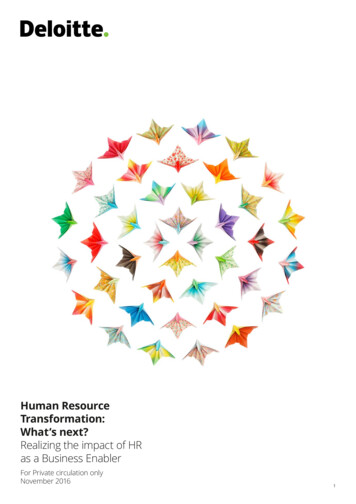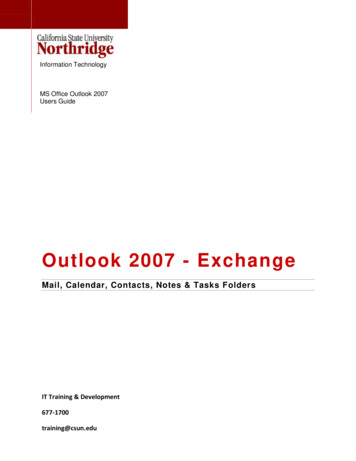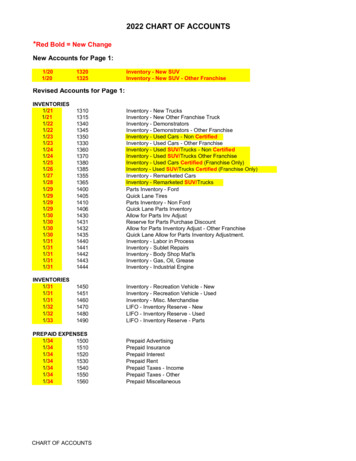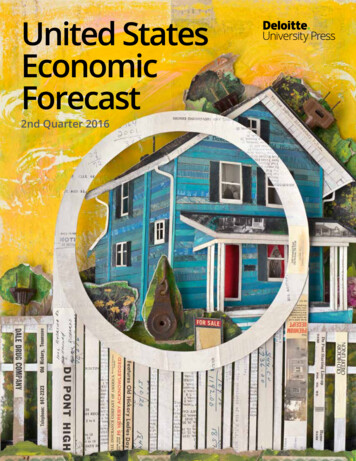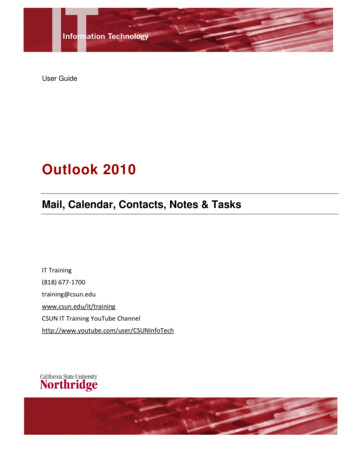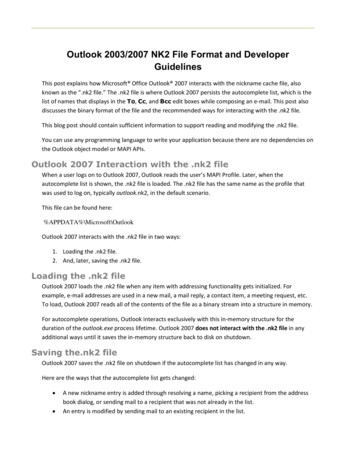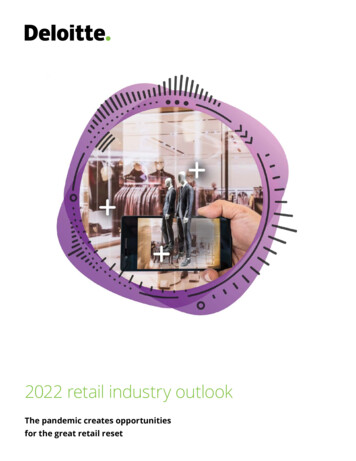
Transcription
2022 retail industry outlookThe pandemic creates opportunitiesfor the great retail reset
2022 retail industry outlook The pandemic creates opportunities for the great retail resetContentsIntroduction3What lies ahead4Reimagine the workforce6Supply chain resiliency8Digital revolution11The road ahead13Outlook methodologyDeloitte surveyed 50 senior executives from retailers across multiple subsectors from October 29 to November 9, 2021.Most companies are multinationals, all have at least 1 billion in annual revenue, and 56% have 10 billion or more inannual revenue. The respondents include C-suite and senior executives who are directly responsible for or exert significantinfluence on major strategic initiatives. In addition, we also conducted interviews with 15 Deloitte retail subject-matterspecialists in November 2021.2
2022 retail industry outlook The pandemic creates opportunities for the great retail resetIntroductionFor nearly two years, the predictionsabout the future of retail have seemeddire. The retail headlines for 2022 don’tlook much better—empty store shelves,over 1 million retail jobs unfilled,1surging inflation, and organized bandsof criminals ransacking stores.But these headwinds have also yielded some positive results:Retailers have been forced to reexamine their legacy systems andstrategies that have shaped the industry for years. In many ways, thepandemic has opened the door for a long-overdue great retail resetthat can help move many retailers into more stable—and potentiallymore profitable—positions than ever before.To realize long-term and lasting benefits, however, retailers shouldcontinue down the remediation path they began at the onset ofthe pandemic. In fact, 2022 offers opportunities to restructureoutmoded supply chains, rightsize inventory management, reviewpricing, recalibrate promotional cadences, and reinvent the physicalstore. This will likely require major transformational thinking andlong-term commitments from retailers, but these efforts couldforever shift the way retailers conduct business.That future begins today by addressing near-term retail challengeswith an eye to the future. Now is an ideal time to take stock ofthe market to better understand what traits separate those whoembrace the reset—the leaders—from the rest of the pack.2 Weasked 50 retail executives to share their views on where they seethe industry in the next 12 months. The resulting data, combinedwith insights derived from client work and prior research, offers asnapshot of strategies and investment plans that help inform thefuture of the industry. For 2022, several priorities emerged that wediscuss in more detail below—namely workforce retention, supplychain resiliency, and digital investments.3
2022 retail industry outlook The pandemic creates opportunities for the great retail resetWhat lies aheadIndustry and consumer outlookBefore addressing the strategic priorities of the retail industry,it may be instructive to first examine expectations for the economy,industry, and consumer. This can help provide further context forthe strategic priorities that follow.With consumers muddling through the pandemic since early 2020,time and experience have yielded some clarity for retailers aboutwhat to expect moving forward. Despite increasing bifurcation,9executives are confident that consumer behavior is moving in theirfavor, especially around the willingness to spend and a return to inperson experiences. However, recent consumer data suggests thatconsumers are rethinking priorities, with one-third of consumerssaying they are spending more on experiences than possessionscompared to a year ago.10Economic outlookEverything changed in 2021, and for the better. Effective vaccinesand greater general knowledge of COVID-19 increased consumerconfidence, which resulted in an uptick in consumer spending,3especially in food services, transportation, and recreation services.4The labor market also played a key role, with the unemploymentrate dropping significantly while consumers also benefited fromstrong earnings growth.5 As the economic recovery gathers steam,consumers are also spending more and saving less than what theydid in 2020.Executives appear optimistic about revenue growth and marginsfor 2022 (figure 1). Some are even taking perceived headwinds andturning them into opportunities. For example, 58% saw inflationas an opportunity to take price and improve margins. Others arerethinking their old buying and discounting cadences. With fewerproducts to sell, some stores even stopped offering promotions,thereby boosting profits. Others built on strategies already in theworks, such as closing unprofitable locations and strengthening theirpositions to emerge from the pandemic.11All of this is a good sign for retailers in the near term. In 2022, weexpect the economic recovery to continue at a strong pace withGDP rising by 3.5% in 2022.6 Given this scenario of high growthand reduced health concerns, we forecast real personal consumerspending (PCE)7 to expand through 2022.8 We expect services tolead the recovery in 2022, while durable goods should decline,given the strong growth in the category in 2020–2021.Expectations for the2022 consumerActive and outgoing,seeking experiencesoutside the home(84% in 2022 vs. 42%in 2021) illing to spend butWhaving to rely moreon credit or buy now,pay later (64%)Expecting seamlessexperience acrosschannels (96%)Pursuing retailerswith strong ESGinitiatives (68%)4Figure 1. 2022 retail executive expectations2022 industry revenue growth*54%Expect growthup to 5%32%YoY operating margin expectationsStable38%Lower30%Expect growth of5% or moreHigher32%OpportunitiesChallenges Favorable consumer behavior Consumer bifurcation Use inflation as an opportunity to improvemargins (58% agree) Employee shortages will hamper growth(70% agree) Take price/reset promotional cadence(over buying/discounting) Supply chain disruption will impact growth(68% agree) Consumers expect timely delivery (64% agree)*Note: Remaining 14% expect flat or lower sales; 6% expect a decline in sales; 8% expect flat sales in 2022
2022 retail industry outlook The pandemic creates opportunities for the great retail resetNewfound opportunities emerging from thedownturn are additional indicators that thepandemic is spurring a retail reset. Thoughwith other retail headwinds such as supplychain and labor shortages pushing againstprogress, it appears that lasting optimismmight be tenuous for now. In evaluatingwhere retailers plan to invest in 2022, it’sapparent that some are seeking short-termstopgap measures, while others are workingto ensure that today’s solutions will havemore lasting effects on their businessesdown the road.Many retailers will face similar challenges in2022, so it was not surprising that at least80% of the executives surveyed plan tomake moderate-to-major investments indigital and supply chain. What stood out,however, is that leaders are differentiated bytheir views and actions around areas suchas digitization, incorporating ESG practices,and making the workforce future-ready(figure 2).Methodology:Leaders and laggardsWe assigned scores to each respondent for the items below:1. Annual revenue growth in the most recently completed fiscal year2. Proportion of revenue derived from digital channels in the mostrecently completed fiscal year3. C onfidence in their organization’s ability to execute its businessstrategy successfully in 2022The sample of 50 respondents was split into three groups based onthe aggregate scores derived from the above.The top 25% aggregate scores were classified as“leaders” (n 11) and the bottom 25% were classified as“laggards” (n 13).Figure 2. Company strategy relative to competitors versus planned financial investment in 2022Leaders support strategies with investment, while laggards invest significantly even in areas where strategies are not advancedLaggardsLeaders% Competitive/advanced strategy relative to others100%100%Tapping alternativehigher-marginrevenue streamsResetting physicalstores foromnichannelExpanding digitalcapabilitiesEngaging in M&ATapping alternativehigher-marginrevenue streams50%Enhancing dataprivacy andsecurityEngaging in M&AMaking theworkforcefuture-readyResetting physicalstores foromnichannelExpanding digitalcapabilitiesIncorporatingESG practicesEnhancing data privacyand securityModernizing thesupply chain50%Making the workforcefuture-readyModernizing thesupply chainIncorporatingESG practices0%0%0%50%100%0%50%100%% Moderate/major planned investments1. For the following strategies, please assess how advanced your company’s strategy is relative to others in your industry. (N 50)2. P lease choose the answer that best describes the size of the financial investment your company will make in the followingstrategies in the upcoming year (2022). (N 50)5
2022 retail industry outlook The pandemic creates opportunities for the great retail resetReimagine the workforceThe Great Resignation has brought workforce issues to theforefront of industry discussions. Even as recently as one yearago, the problems the industry faces today would have seemedunlikely, especially given where the economy was headed and howworkforce reductions were far more commonplace at the time.With all the pandemic-related uncertainty, it seemed that no onewould voluntarily leave a job without lining up something else first.Many retailers are in a tough spot, and 83% said they are having toinvest most heavily in recruiting new employees and retaining them.With executives noting that labor issues are top retail concerns,retailers should reset the way they think about employees as theyplan for the future. The issue goes far deeper than merely salaries.Priorities have shifted for employees, especially around flexibility,culture, and diversity, equity, and inclusion (DEI).Employer pain pointsLooking ahead, many retail executives see labor shortages as aleading concern, especially because it may be difficult to competewith the flexibility of the gig economy for hourly wage employees.The figures are daunting: 70% of executives say labor shortages—especially in hourly wage jobs—will hamper retail growth in 2022.Currently, the biggest pain point for retailers is at the store level, and74% expect shortages in customer-facing positions in 2022. Giventhe pervasiveness of the situation, retailers have little choice butto address the problem or adapt the business model. Warehousepositions are also expected to be problematic, and 56% expectshortfalls in hourly supply chain, distribution, and logistics positions.Turnover has always been an issue with these jobs, but it hasaccelerated even further because of the additional pressures put onworkers by the pandemic.Retailers should look to invest in a workforce for the future, focusingon technology and automation to rely less on physical labor. It maybe difficult to imagine today, but more than half of leaders (vs. 31%of laggards) believe that staff-free stores will be common within thenext five years.6Digital talent shortageAlso concerning is that nearly half of executives expect a shortagein skilled workers for IT and analytics positions—needed rolesthat require greater investment and will likely be the foundationof digitally enabled retail. The shortage is compounded by the factthat retail is competing against virtually every other industry fortalent; retailers need to solidify why they are more attractive thanbig tech for high-demand workers. Hiring for technology-drivenroles will likely require retail to move at a much faster pace inadopting the latest and greatest technology to compete with farmore tech-savvy industries.“ The draw to retail for an aspiring,agile brainiac who wants to do allthese really cool things from atechnology perspective just isn’t there—especially when you’re a retailer thatis still arm wrestling with on-premisestechnology that was installed duringthe dinosaur age.”—Deloitte human capital specialist
2022 retail industry outlook The pandemic creates opportunities for the great retail resetReshaping talent prioritiesAs retailers look to address the war for talent, they shouldunderstand how the pandemic has reshaped priorities. Recent datashows the collective experience of the pandemic has induced aperiod of self-reflection for wage earners.12 In particular, there is agreater focus on introspection and well-being, and a divide betweenmoney and purpose. There is also a strong desire to work fromhome more frequently.13 Current retail workforce structures seemdestined to clash with evolving employment expectations.Retailers should take a page from leaders’ playbooks, inside andoutside the industry, and look beyond pay for ways to improve theeveryday workforce experience (figure 3). They should considerways to infuse culture, flexibility, and purpose to hire and retainemployees. Our research bolsters this thinking: 94% believethat employees prefer workplaces that consider DEI. And while86% plan to make moderate-to-major investments in DEI, suchinvestments are generally focused on programming and training.These are important, but retailers can improve the return on theseinvestments by focusing on outcomes and considering what careeradvancement looks like in the organization.In addition, evolving priorities will likely require retailers to addresshow they represent themselves in the marketplace, from diversityof suppliers to career advancement for historically marginalizedgroups. The way a company presents its brand can be a vital partof the retail reset and gaining competitive advantage. Adapting tochanging marketplace conditions and evolving the narrative aroundthe brand can help make customers, vendors, and employees feelincluded and, more importantly, connected with the brand.Figure 3. Company workforce strategy in 2022Leaders will prioritize automation and workforce experience over outsourcing% of respondentsLeaders, 82%Middle, 81%Leaders, 91%Middle, 88%Laggards, 69%Laggards, 46%Middle, 38%Laggards, 31%Leaders, 9%Outsourcingwherever possiblewill be a high priorityAutomation whereverpossible will be ahigh priorityImproving the everydayworkforce experiencewill be a high priority1. I n the context of your company’s workforce strategies, to what extent do you agree with the following statements for 2022?(Percentage that agree/strongly agree).Sample size (N) 507
2022 retail industry outlook The pandemic creates opportunities for the great retail resetSupply chain resiliencyFailures up and down the supply chain during the pandemic havelaid bare persistent issues with the manufacture and movement ofgoods around the world. Though it shouldn’t have come as a realsurprise, the sudden and simultaneous shutdowns demonstratedin real time that the status quo would no longer suffice. True supplychain resiliency will likely require significant change across the board.Resets don’t happen overnight, but retailers can’t afford to waitgiven that 80% of executives said they believe that consumers willprioritize stock availability over retailer loyalty in the upcoming year.As retailers look to take action, it’s important to understandthat just as shifting priorities from the pandemic have changedemployee expectations, they have also altered the way consumersshop. Where and when customers make their purchases are farless predictable these days. Consumers have become merchantsin their own right, buying from a broad range of retail channels,curating and promoting their own array of products via their socialmedia accounts, reselling used goods through digital platforms, andsetting the terms for how purchases arrive on their doorsteps.14 Andmany current supply chain capabilities—around demand planning,inventory management, and fulfillment forecasting—aren’t setup to handle such scenarios. Organizations need more credibleinformation and technology upgrades to develop agile systems thatcan handle the new consumer scenarios.8“ You don’t build an agile supplychain. Buildings don’t go upovernight, automation isn’t putin overnight. Agility means beingable to adjust to the changes incustomer behavior, to sense andget them ahead of that, and thenhelp shape their behavior.”—Deloitte supply chain specialist
2022 retail industry outlook The pandemic creates opportunities for the great retail resetLeaders look to automateAutomation in distributionwill be a higher priorityfor leadersAs expected, fulfillment and inventory and warehouse managementare expected to attract the most investments in 2022. However, 57%of executives still have no plans to invest in robotics and automatedmaterial handling. This is particularly concerning given the currentworkforce challenges the industry faces. Leaders are making thisa higher priority, and forward-thinking retailers should strive toautomate their processes as much as possible and consider makingsignificant investments in automated driving technology and lastmile delivery (figure 4).1533%Automation indistribution/fulfillment centerswill be a priority11% Laggards50% LeadersFigure 4. Assessment of supply chain technologiesTop 10 major upgrades to supply chain technology% of respondentsRelevant modules in company’s ERP40%Inventory managementSupply chain analytics softwareFulfillment37%Dropship management23%20%Distributed order management17%Real-time traceability17%Logistics/transportation management system13%Major upgrade iscurrently ongoing10%27%23%Major upgrade willstart within 24 months20%13%30%Warehouse management systemSupply risk 0%10%23%10%20%40%23%23%27%20%27%23%17%Technology iscurrently up-to-date30%No plans to investin this technology1. P lease provide an assessment of the below supply chain technologies at your company; Chart does not include “Don’t Know” responses.Sample size (N) 309
2022 retail industry outlook The pandemic creates opportunities for the great retail resetCreate transparencyAs it becomes apparent that the supply bottleneck may take yearsto sort out, retailers should position themselves to plan for thefuture—not just by investing in new technologies and automationbut also cultivating transparency today. Transparency and conveyinginformation across the end-to-end process are often necessaryingredients to help maximize the impact of technology investmentsgoing forward.Case in point, suppliers for mass merchants and large grocers havelittle insight into what those companies expect to sell or mightdiscount in the future. Suppliers can be left guessing what retailerswill order, creating potential supply chain and delivery issues downthe road. Given that retailers must compete against large, verticallyintegrated players who have more “perfect” (read: transparent)information, it can be mutually beneficial to share informationacross partners.16Retailers, therefore, should pivot toward transparency, sharinginformation more openly, completely, and with lead time, to helptheir partners upstream plan accordingly. In a nutshell, as onesubject-matter specialist put it, “There can be no secrets anymore.Not sharing information is just detrimental to everyone.”10Collaborate with new partnersNot every retailer can scale to compete with large players that areutilizing their data to maximize supply chain efficiencies and offerpersonalized experiences. Those that are unable to scale shouldpursue other options like transparency, accessing underutilizedassets, and collaborating with new partners. For example, retail realestate owners and retailers could share analytics and use existinginfrastructure to help provide more seamless shopping experiencesand last-mile solutions to better compete.
2022 retail industry outlook The pandemic creates opportunities for the great retail resetDigital revolutionIn 2022, we expect the fusion of digital and physical experiences toaccelerate further. Retailers should make significant investmentsthat not only meet the e-commerce needs of the present, but alsothose of the future.A key takeaway from the pandemic has been that consumers havereset their level of reliance on technology and digital platforms.Virtual work, school, and entertainment now fill homes with moregadgets and accessories. In addition, consumers tried and adoptednew and innovative ways to shop. Even in our recent back-to-schooland holiday studies, consumers indicated that though they feel morecomfortable returning to stores, their preference for online channelsremains higher than before the pandemic.“Hardware is ubiquitous, and there israpidly growing opportunity to expandretailers’ footprint by turning ‘everywhere’into selling opportunities. The trick isto create a seamless and simple userexperience, and to get the fulfillmentdone as quickly as possible.”—Deloitte digital specialistLeaders and laggards are mostly aligned on how they plan to investin 2022 around e-commerce, digital marketing, and automatedcheckout, but differ in their views and investments further out.Over the next five years, leaders are buying into the prospects ofdigitization of the physical world, such as voice commerce, staff-freecashier-less stores, and selling of digital goods. It’s interesting to notethat more laggards aren’t expecting these trends to be adopted,given that the technologies have been discussed for years (figure 5).Figure 5. Most likely to occur in the next five yearsLeaders are more optimistic about the prospects of digital goods and voicecommerce and less optimistic about usage of cryptocurrencies% of respondentsVoice commerce will be widely adoptedLeaders55%38%Retailers will increasingly engage consumersthrough digital goods64%31%Staff-free, cashier-less stores will be commonCryptocurrencies will be widely used by retailersand consumers alikeLaggards0%55%38%0%1. D igital goods include goods sold in video games, the metaverse, and/or as nonfungible tokens (NFTs). Voice commerce is defined as using voicecommands to find and purchase products online. Which of the below are most likely to occur in the next five years? Please select up to three.Sample size (N) 5011
2022 retail industry outlook The pandemic creates opportunities for the great retail resetMake marketing countWhere retail executives plan to spend their budgets is quite telling,with 70% planning for moderate to major investments in digitalmarketing. This indicates that retailers are looking to gain marketshare by finding new customers but also trying to figure out how toturn more in-store shoppers into online shoppers. Clearly, shoppersare more profitable when they’re spending on both channels.17Looking for a quick fix with digital marketing to get more traffic totheir sites and generate sales serves as an effective short-termstrategy, but retailers should continue to focus on how they defineand measure their digital success going forward.Given the significant investments in digital marketing, retailersshould consider exploring the metaverse, especially as 64% ofleaders expect retailers to engage with customers around digitalgoods in the next five years. Although retailers have already startedexperimenting with the metaverse as luxury brands sell virtualaccessories for avatars, and athletic companies operate storeson the Roblox platform, retailers should work to get an early startto help increase brand recognition with a more tech-savvy targetdemographic.18 Working to translate physical-world offerings intodigital ones can create marketing opportunities to hold virtualproduct launches, events, and other exclusive—and value-added—metaverse experiences that can have lasting impact inthe marketplace.Infrastructure needed for omnichannelSome 67% of respondents cited e-commerce and online shoppingplatforms as top investment areas, given that many organizationsare still dealing with old and outdated platforms. Some retailersstill do not utilize cloud services and need new next-generatione-commerce platforms to support their growing banners and theirfuture digital ambitions. Shifting customer expectations are makingold e-commerce solutions seem even more outdated, especiallyas users demand new capabilities and experiences that are notcurrently supported.COVID-19 has shown that the role of the store isn’t going away, butit’s changing, and stores more than ever are needing to support bothtraditional shopping patterns and omnichannel fulfillment activities.This is forcing retailers to rethink their in-store investments and whatinfrastructure they need to be both resilient and agile. Our surveyfound that only one-fourth are prioritizing store investments in2022. Retailers can and should make this a higher priority. In general,legacy technologies that retailers run in-store cannot support futurefacing customer and associate needs, and ultimately, they maycreate unacceptable operational risk.12For years, connectivity, bandwidth, and security have limited retailersin deploying in-store technology. Minimal and zero infrastructureflips the script, allowing retailers to invest, and incentivizes themto connect solutions that address operations, experience, andefficiency. In addition, a zero-Infrastructure mindset allows for moregranular control over costs, service quality, security, and applicationsacross sites. In an ideal world, plug-and-play integration shouldemerge between devices and solutions, along with the ability todeploy workloads when and where needed. Retailers that adoptthese types of solutions can harness the power of distributedinfrastructure at scale and evolve store technology as rapidly asbusiness solutions demand.Prioritize data privacy and securityAnother concern is that only one-fourth of executives planned tomake major investments in data privacy and security. Perhaps thereis a false sense of confidence from those who have not experienceddata breaches or ransomware attacks, given that threat activity hasincreased exponentially during the pandemic. A 2021 study foundthat the retail industry was hit the hardest by ransomware, with44% of retailers attacked globally.19 And as retail increases its digitalpresence, from cashier-less stores to drone deliveries, the attacksurface expands. Retailers are likely not investing enough now toreduce the risk in a more-digitized retail world five years from now.In the end, the retail reset will likely require retailers to adequatelyprepare for the digitization of the physical world. Ultimately, thegoal is to create a seamless shopping experience in omnichannel.But that entails preparations beyond the online world and includesdata privacy and security technologies for the physical space as wellto help create a seamless transition. Investments in analytics canhelp retailers prepare to address the rapidly shifting priorities ofconsumers faster than their competitors—while helping to ensurethat security and data privacy initiatives are in place to maintainconsumers’ trust.
2022 retail industry outlook The pandemic creates opportunities for the great retail resetThe road aheadRetailers face significant challenges that will likely last beyond thepandemic, but there are also unexpected opportunities that canhelp them prepare for future disruptions. Retailers must figureout how to reset—as employers, at meeting consumer needs,and by being better corporate citizens—to compete in the nextera of retail. Retailers should embrace the current disruption andcommit to pivot toward the future.13
2022 retail industry outlook The pandemic creates opportunities for the great retail resetAuthorsRod SidesVice chairmanUS Retail, Wholesale & Distribution leaderDeloitte LLP 1 704 887 1505rsides@deloitte.comLupine SkellyResearch leaderUS Retail, Wholesale & DistributionDeloitte Consumer Industry CenterDeloitte Services LP 1 206 716 7187lskelly@deloitte.comAcknowledgmentsThe authors would like to thank Brian Baker, Kimberly Betts, Oscar Burakoff, Bryan Furman,Susan Hogan, Anthony Jardim, Diana Kearns-Manolatos, Nadav Magnezi, Kusum Manoj Raimalani,Manogna Marthi, Kevin Meagher, Srinivasarao Oguri, Anup Raju, and Venkata Sangadi.14
2022 retail industry outlook The pandemic creates opportunities for the great retail resetEndnotes1.Abha Bhattarai, “Macy’s offers corporate workers a ‘valuable opportunity’: In-store shifts,” Washington Post, November 17, 2021.2.Leaders and laggards methodology: We assigned scores to each respondent for annual revenue growth in the most recently completed fiscalyear; proportion of revenue derived from digital channels in the most recently completed fiscal year; and confidence in their organization’sability to execute its business strategy successfully in 2022. The sample of 50 respondents was split into three groups based on theaggregate scores derived from the above. The top 25% aggregate scores were classified as “leaders” (n 11) and the bottom 25% wereclassified as “laggards” (n 13).3.United States Department of Commerce, sourced through Haver Analytics on December 7, 2021. Unless otherwise stated, all data onconsumer spending is from this source.4.Akrur Barua, Daniel Bachman, and Lester Gunnion, Consumer spending forecasts: Services find their way back after a forgettable 2020, DeloitteInsights, 2021. All consumer spending–related forecasts are from this source.5.United States Bureau of Labor Statistics (BLS), Household Survey, sourced through Haver Analytics on December 7, 2021. All labor marketdata is from this source.6.Daniel Bachman, US Economic Forecasts: 4th Quarter 2021, Deloitte Insights, 2021.7.Real consumer spending refers to inflation-adjusted spending. We focus on real spending in this brief.8.Barua, Bachman, and Gunnion, Consumer spending forecasts.9.Sarah A. Donovan, Joseph Dalaker, Marc Labonte, and Paul D. Romero, The U.S. income distribution: Trends and issues, Congressional ResearchService, 2021, p. 1.10. Deloitte, “Global State of the Consumer Tracker,” accessed November 15, 2021.11. Suzanne Kapner, “T
2022 retail industry outlook The pandemic creates opportunities for the great retail reset Outlook methodology Deloitte surveyed 50 senior executives from retailers across multiple subsectors from October 29 to November 9, 2021. Most companies are multinationals, all have at least 1 billion in annual revenue, and 56% have 10 billion or more in

